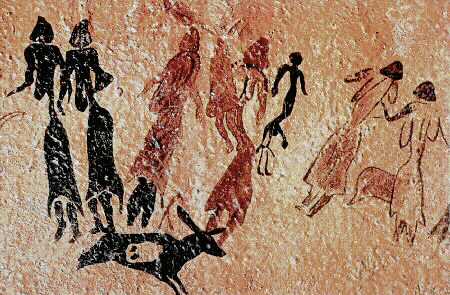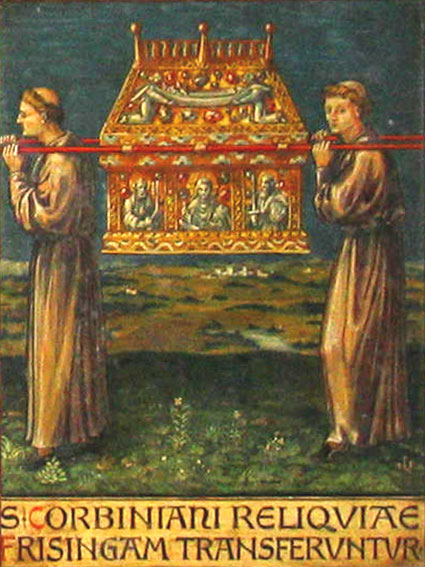|
Arnold Scholasticus
Arnold Scholasticus was an 11th century monk of the Benedictine abbey of Santa Maria, Ripoll (Catalonia). He served the community as scholaster, calligrapher, painter, and notary, considerably enhancing the reputation of the monastic school and the scriptorium. He was the author of ''Qualiter corpus beati Stephani de Ierosolimis Constantinopolim sit translatum, xix kal. ianuarii'', a reworking of a text by Anastasius Bibliothecarius on the translation of the remains of Saint Stephen from Jerusalem to Constantinople la, Constantinopolis ota, قسطنطينيه , alternate_name = Byzantion (earlier Greek name), Nova Roma ("New Rome"), Miklagard/Miklagarth ( Old Norse), Tsargrad ( Slavic), Qustantiniya (Arabic), Basileuousa ("Queen of Cities"), Megalopolis ( .... He also painted animals in imitation of Roman mosaic in the apse of the abbey church.A. Lambert, "Arnold Scholasticus", ''Dictionnaire d'histoire et de géographie ecclésiastiques'', vol. 4 (Paris, 1930), 572-573. Re ... [...More Info...] [...Related Items...] OR: [Wikipedia] [Google] [Baidu] |
Santa Maria, Ripoll
The Monastery of Santa Maria de Ripoll is a Benedictine monastery, built in the Romanesque style, located in the town of Ripoll in Catalonia, Spain. Although much of the present church is 19th century rebuilding, the sculptured portico is a renowned work of Romanesque art. History The Monastery of Santa Maria de Ripoll was founded in 888 by Count Wilfred the Hairy (called Guifré el Pilós in Catalan) who used it as a centre to bring about the repopulation of the region after conquering it. Wilfred's son, Ridulph, was educated there and was later abbot of the monastery, as well as bishop of Urgell. The monastery grew rapidly, and was subsequently reconsecrated in 935, 977 and 1032, though the monks are known to have been established there permanently only from 1025 or 1032. The scriptorium and the monastic school quickly gained renown under Arnold Scholasticus. The monastery had several offshoots which included the abbeys of St. Martin-du-Canigou (now in France) and that of San ... [...More Info...] [...Related Items...] OR: [Wikipedia] [Google] [Baidu] |
Catalonia
Catalonia (; ca, Catalunya ; Aranese Occitan: ''Catalonha'' ; es, Cataluña ) is an autonomous community of Spain, designated as a '' nationality'' by its Statute of Autonomy. Most of the territory (except the Val d'Aran) lies on the northeast of the Iberian Peninsula, to the south of the Pyrenees mountain range. Catalonia is administratively divided into four provinces: Barcelona, Girona, Lleida, and Tarragona. The capital and largest city, Barcelona is the second-most populated municipality in Spain and the fifth-most populous urban area in the European Union. > > > ''Catalonia'' theoretically derived. During the Middle Ages, Byzantine chroniclers claimed that ''Catalania'' derives from the local medley of Goths with Alans, initially constituting a ''Goth-Alania''. Other theories suggest: *''Catalunya'' derives from the term "land of castles", having evolved from the term ''castlà'' or ''castlan'', the medieval term for a castellan (a ruler of a castl ... [...More Info...] [...Related Items...] OR: [Wikipedia] [Google] [Baidu] |
Scholaster
A scholaster, from the Latin ''scholasticus'' (schoolmaster), or magister scholarum, was the head of an ecclesiastical school, typically a cathedral school, monastic school, or the school of a collegiate church, in medieval and early-modern Europe.Peter Nissen and William den Boer, "The Middle Ages after 1200", in ''Handbook of Dutch Church History'', edited by Herman Selderhuis (Göttingen, 2014), pp. 141–142. Depending on the size of the school and the status of the institution to which it was attached, the scholaster might be the only teacher, the head of a considerable educational establishment, or have oversight over all the schools in their city or territory. The scholaster might be a dignitary in a cathedral or collegiate chapter, alongside the provost, dean, cantor, succentor, precentor, archdeacon, treasurer, cellarer, sacristan or almoner An almoner (} ' (alms), via the popular Latin '. History Christians have historically been encouraged to donate one-tenth o ... [...More Info...] [...Related Items...] OR: [Wikipedia] [Google] [Baidu] |
Calligrapher
Calligraphy (from el, link=y, καλλιγραφία) is a visual art related to writing. It is the design and execution of lettering with a pen, ink brush, or other writing instrument. Contemporary calligraphic practice can be defined as "the art of giving form to signs in an expressive, harmonious, and skillful manner". Modern calligraphy ranges from functional inscriptions and designs to fine-art pieces where the letters may or may not be readable. Classical calligraphy differs from type design and non-classical hand-lettering, though a calligrapher may practice both. CD-ROM Calligraphy continues to flourish in the forms of wedding invitations and event invitations, font design and typography, original hand-lettered logo design, religious art, announcements, graphic design and commissioned calligraphic art, cut stone inscriptions, and memorial documents. It is also used for props and moving images for film and television, and also for testimonials, birth and death c ... [...More Info...] [...Related Items...] OR: [Wikipedia] [Google] [Baidu] |
Painter
Painting is the practice of applying paint, pigment, color or other medium to a solid surface (called the "matrix" or "support"). The medium is commonly applied to the base with a brush, but other implements, such as knives, sponges, and airbrushes, can be used. In art, the term ''painting ''describes both the act and the result of the action (the final work is called "a painting"). The support for paintings includes such surfaces as walls, paper, canvas, wood, glass, lacquer, pottery, leaf, copper and concrete, and the painting may incorporate multiple other materials, including sand, clay, paper, plaster, gold leaf, and even whole objects. Painting is an important form in the visual arts, bringing in elements such as drawing, composition, gesture (as in gestural painting), narration (as in narrative art), and abstraction (as in abstract art). Paintings can be naturalistic and representational (as in still life and landscape painting), photographic, abstract, ... [...More Info...] [...Related Items...] OR: [Wikipedia] [Google] [Baidu] |
Notary
A notary is a person authorised to perform acts in legal affairs, in particular witnessing signatures on documents. The form that the notarial profession takes varies with local legal systems. A notary, while a legal professional, is distinct from an advocate in that they do not represent the person who engages their services, or act in contentious matters. The Worshipful Company of Scriveners use an old English term for a notary, and are an association of notaries practising in central London since 1373. Overview Documents are notarized to deter fraud and to ensure they are properly executed. An impartial witness (the notary) identifies signers to screen out impostors and to make sure they have entered into agreements knowingly and willingly. Loan documents including deeds, affidavits, contracts, and powers of attorney are very common documents needing notarization. Code of Hammurabi Law 122 (c. 1755–1750 BCE) stipulated that a depositor of gold, silver, o ... [...More Info...] [...Related Items...] OR: [Wikipedia] [Google] [Baidu] |
Monastic School
Monastic schools ( la, Scholae monasticae) were, along with cathedral schools, the most important institutions of higher learning in the Latin West from the early Middle Ages until the 12th century. Since Cassiodorus's educational program, the standard curriculum incorporated religious studies, the Trivium, and the Quadrivium. In some places monastic schools evolved into medieval universities which eventually largely superseded both institutions as centers of higher learning. History Since the cenobitic rule of Pachomius (d. 348 AD) and the sixth-century Rule of the Master and the Rule of St. Benedict, monks and nuns were required to actively engage in reading. This reading took on the characteristics of a school that dealt with both religious and secular subjects. Beginning in the 5th century, a variety of abbots took upon themselves the responsibility of educating those who entered the monastery at a young age. The earliest of these monastic schools had more of a spiritual ... [...More Info...] [...Related Items...] OR: [Wikipedia] [Google] [Baidu] |
Scriptorium
Scriptorium (), literally "a place for writing", is commonly used to refer to a room in medieval European monasteries devoted to the writing, copying and illuminating of manuscripts commonly handled by monastic scribes. However, lay scribes and illuminators from outside the monastery also assisted the clerical scribes. The functional outset When monastic institutions arose in the early 6th century (the first European monastic writing dates from 517), they defined European literary culture and selectively preserved the literary history of the West. Monks copied Jerome's Latin Vulgate Bible and the commentaries and letters of early Church Fathers for missionary purposes as well as for use within the monastery. In the copying process, there was typically a division of labor among the monks who readied the parchment for copying by smoothing and chalking the surface, those who ruled the parchment and copied the text, and those who illuminated the text. Sometimes a single mon ... [...More Info...] [...Related Items...] OR: [Wikipedia] [Google] [Baidu] |
Anastasius Bibliothecarius
Anastasius Bibliothecarius or Anastasius the Librarian (c. 810 – c. 878) was ''bibliothecarius'' (literally "librarian") and chief archivist of the Church of Rome and also briefly a claimant to the papacy. Early life He was a nephew of Bishop Arsenius of Orte, who executed important commissions as Papal legate. Anastasius learned the Greek language from Eastern Roman monks and obtained an unusual education for his era, such that he appears to be the most learned ecclesiastic of Rome in the 9th century.Kirsch, Johann Peter. "Anastasius Bibliothecarius." The Catholic Encyclopedia Vol. 16 (Index). New York: The Encyclopedia Press, 1914. 13 December 2018 Abbot of Santa Maria and secretary of Nicholas I During the pontificate of |
Translation (relic)
In Christianity, the translation of relics is the removal of holy objects from one locality to another (usually a higher-status location); usually only the movement of the remains of the saint's body would be treated so formally, with secondary relics such as items of clothing treated with less ceremony. Translations could be accompanied by many acts, including all-night vigils and processions, often involving entire communities. The solemn translation (in Latin, ''translatio'') of relics is not treated as the outward recognition of sanctity. Rather, miracles confirmed a saint's sanctity, as evinced by the fact that when, in the twelfth century, the Papacy attempted to make sanctification an official process; many collections of miracles were written in the hope of providing proof of the saint-in-question's status. In the early Middle Ages, however, solemn translation marked the moment at which, the saint's miracles having been recognized, the relic was moved by a bishop or abbot ... [...More Info...] [...Related Items...] OR: [Wikipedia] [Google] [Baidu] |
Saint Stephen
Stephen ( grc-gre, Στέφανος ''Stéphanos'', meaning "wreath, crown" and by extension "reward, honor, renown, fame", often given as a title rather than as a name; c. 5 – c. 34 AD) is traditionally venerated as the protomartyr or first martyr of Christianity."St. Stephen the Deacon" , St. Stephen Diaconal Community Association, Roman Catholic Diocese of Rochester. According to the Acts of the Apostles, he was a deacon in the early Church at who angered members of various |
Jerusalem
Jerusalem (; he, יְרוּשָׁלַיִם ; ar, القُدس ) (combining the Biblical and common usage Arabic names); grc, Ἱερουσαλήμ/Ἰεροσόλυμα, Hierousalḗm/Hierosóluma; hy, Երուսաղեմ, Erusałēm. is a city in Western Asia. Situated on a plateau in the Judaean Mountains between the Mediterranean Sea, Mediterranean and the Dead Sea, it is one of the List of oldest continuously inhabited cities, oldest cities in the world and is considered to be a holy city for the three major Abrahamic religions: Judaism, Christianity, and Islam. Both Israelis and Palestinians claim Jerusalem as their Capital city, capital, as Israel maintains its primary governmental institutions there and the State of Palestine ultimately foresees it as its seat of power. Because of this dispute, Status of Jerusalem, neither claim is widely recognized internationally. Throughout History of Jerusalem, its long history, Jerusalem has been destroyed at least twice, Sie ... [...More Info...] [...Related Items...] OR: [Wikipedia] [Google] [Baidu] |
.jpg)








